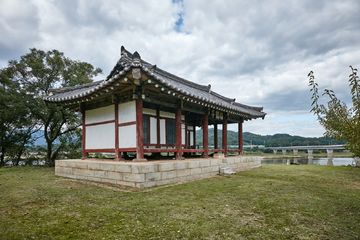매학정 일원
| 매학정 일원 Maehakjeong Pavilion and Surroundings |
|
 매학정 일원, Korea Trip Tips. |
|
| 대표명칭 | 매학정 일원 |
|---|---|
| 영문명칭 | Maehakjeong Pavilion and Surroundings |
| 한자 | 梅鶴亭 一圓 |
| 주소 | 경상북도 구미시 고아읍 강정4길 63-6 (예강리) |
| 지정(등록) 종목 | 경상북도 기념물 제16호 |
| 지정(등록)일 | 1974년 12월 10일 |
| 분류 | 자연유산/명승/자연명승 |
| 수량/면적 | 3,332㎡ |
| 웹사이트 | 매학정 일원, 국가문화유산포털, 문화재청. |
해설문
국문
매학정은 조선 중종 28년(1533)에 세운 정자로, 조선 중기의 명필* 고산 황기로(孤山 黃耆老)가 시와 글을 쓰며 휴식을 취하던 곳이다. 황기로는 진사시*에 급제했으나 벼슬길로 나가지 않고 은둔하여 학문에 임하였으며, 이곳에서 자연을 벗삼아 서예를 즐겼다고 한다. 주변에 매화나무를 심고 학을 길렀다 하여 매학정(梅鶴亭)이라고 불렀다.
후에 매학정은 황기로의 사위 옥산 이우(玉山 李瑀)가 물려받았다. 이우는 신사임당의 넷째 아들로서 율곡 이이의 동생인데, 그 또한 장인인 황기로의 필체에 영향을 받아 명필가로 이름을 떨쳤다.
정자는 조선 선조 25년(1592) 임진왜란 때 불에 타 폐허가 되었다가, 효종 5년(1654) 이우의 증손자인 학정 이동명이 다시 지어 보존하였다. 이후 철종 13년(1862) 또 한 번 화재를 겪어 무너진 것을 새로이 지었고, 1970년대 전면적으로 보수하여 현재에 이르고 있다.
- 명필(名筆): 글씨를 잘 쓰기로 유명한 사람.
- 진사시(進士試): 조선시대 과거 시험의 일종.
영문
Maehakjeong Pavilion and Surroundings
This is where the renowned calligrapher Hwang Gi-ro (1521-1575) first built a pavilion in 1533 to become closer to nature and practice calligraphy. The surrounding landscape is picturesque, with the pavilion situated between Gosan Mountain and the Nakdonggang River.
Born in Gumi, Hwang passed the classics and literary licentiate examination in 1534. However, he never accepted any official posts and lived in seclusion in his hometown, dedicating his life to perfecting his calligraphy skills. This made him one of the most revered calligraphers in Korea. His grandfather Hwang Pil (1464-1526) had requested in his will that a pavilion be built in front of Gosan Mountain, and so Hwang Gi-ro fulfilled this request. The pavilion was named Maehakjeong, meaning “Pavilion of Plum and Crane.”The plum and crane together are a metaphor for a quiet and secluded life, and Hwang Gi-ro is said to have actually planted plum trees and raised cranes in the vicinity of this pavilion. Because Hwang Gi-ro had no sons, he left the pavilion to his son-in-law Yi U (1542-1609), the younger brother of the renowned scholar Yi I (1536-1584). Yi U became a renowned calligrapher himself due to the influence of his father-in-law.
The pavilion burnt down during the Japanese invasion of 1592. In 1654, it was rebuilt by Yi U’s descendants. After a fire destroyed the pavilion again, it was reconstructed in 1862 and underwent a full renovation in 1970.
- 13살에 정자 짓고 14살에 진사시에 합격했다고요? 말이 안되는데요....
영문 해설 내용
이곳은 조선시대의 명필인 황기로(1521-1575?)가 1533년 정자를 짓고 자연을 벗삼아 서예를 즐기던 곳이다. 정자 뒤쪽에는 고산이 있고, 앞쪽에 낙동강이 흐르며 절경을 이루고 있다.
황기로는 구미 출신으로 1534년 진사시에 합격하였으나 벼슬길에 나가지 않고 고향에서 은거하였고, 평생 서예에만 전념하여 대가가 되었다. 할아버지 황필(1464-1526)의 유지를 받들어 고산 앞에 정자를 지었으며, 앞마당에 매화나무를 심고 학을 길렀다 하여 '매학정'이라 불렀다. 황기로는 아들이 없었기 때문에, 매학정을 비롯한 유산을 사위인 이우(1542-1609)에게 물려주었다. 이우는 저명한 학자인 이이(1536-1584)의 동생이며, 그 또한 장인인 황기로의 필체에 영향을 받아 명필가로 이름을 떨쳤다.
정자는 1592년 임진왜란 때 불에 타 폐허가 되었다가, 1654년 이우의 후손이 다시 지었다. 1862년 화재로 무너진 것을 다시 지었고, 1970년에 전면적으로 보수하였다.
참고자료
- "구미 매학정", 경북일보, 2017.12.14. https://www.kyongbuk.co.kr/news/articleView.html?idxno=1012116&sc_serial_code=SRN116
- "매학정 일원", 디지털구미문화대전. http://gumi.grandculture.net/gumi/toc/GC01202469
- "황기로", 디지털구미문화대전. http://gumi.grandculture.net/gumi/toc/GC01201428
- "황기로", 한국학중앙연구원. http://encykorea.aks.ac.kr/Contents/Item/E0065097
- 황기로의 몰년을 알려 주는 명확한 기록은 없으나, 그가 남명 조식(曺植) 문하의 동문 박제현(朴齊賢)을 위해 1575년에 제문을 써 주었고, 권호문(權好文)이 1579년에 이우의 글씨를 보고 고인이 된 황기로의 필적과 닮았다고 언급한 기록을 종합해 볼 때, 그의 몰년은 1575년에서 1579년 사이로 추정된다.